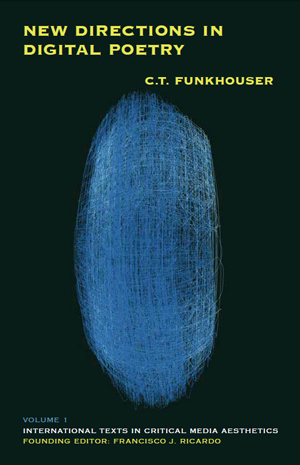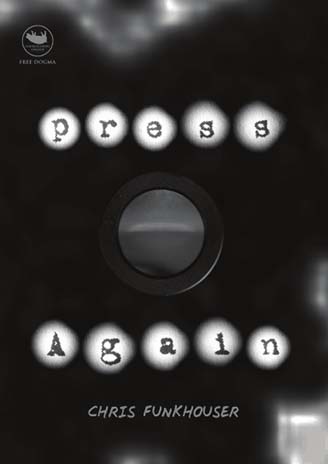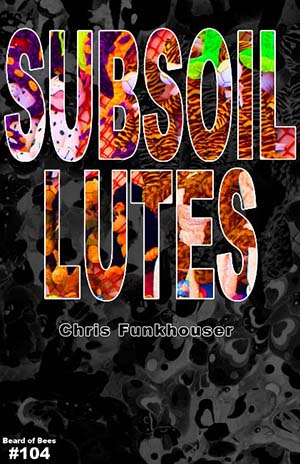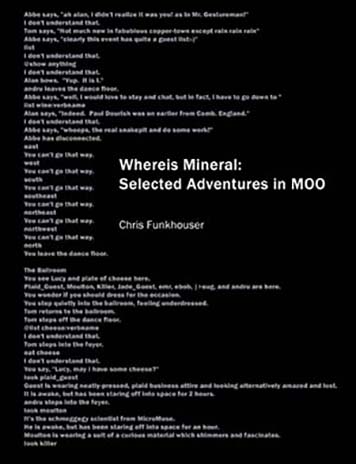University of Alabama Press info page
Amazon.com ordering / monoskop link

Prehistoric Digital Poetry (& other publication) info page
University of Alabama Press info page Amazon.com ordering / monoskop link |
 |
Reviews:
This superbly conceived, elegantly written, meticulously researched, and astonishingly learned history of digital poetry in the decades leading up to the emergence of the World Wide Web will be required reading for anyone interested in the state of poetics today. Funkhouser traces the line from Oulipo and Concrete Poetry via kinetic poetry, hypertext, hypercard, and holography, to the mesostics and diastics made from computerized source texts by John Cage and Jackson Mac Low, to the “transliteral morphs” of John Cayley’s "text-movie” windsound, and beyond. An encyclopedia of forms and possibilities, this is that rare scholarly production—an indispensable book.
Marjorie Perloff
For the foreseeable future, the archiving of digital literature will continue to pose formidable problems. We must face the reality that many works—perhaps even most—will become unplayable and, without the benefit of migration or emulation, simply inaccessible. The description of such works will therefore become more and more important as time passes; this may be the only way in which we can build a corpus and acquire the indispensable resource of a long and deep canon of digital literature.
Given this situation, Chris Funkhouser’s study, Prehistoric Digital Poetry: An Archeology of Forms, 1959-1995, is an exemplary archival contribution...
This is by far the most generous text I've seen on the origins and meanderings of digital literary-plus forms; I think it's fundamental, if anything is. Funkhouser ranges over a vast territory, from codeworks through concrete poetry, from Mac Low to hypercard. This should be essential reading in any experimental/new media/electronic literature/writing class; it's also fun!
Prehistoric Digital Poetry is important to rhetorical scholars not only because poetry is a powerful form of rhetoric, but because the intersections between digital, visual, and literary rhetorics detailed in the book can offer new directions of study for rhetorical and media scholars. Digital poetry's history is thoroughly described in Funkhouser's text, offering scholars a unique opportunity to rhetorically examine this kind of writing as a product of shifting technologies and cultures.
This is an incredible compendium of decades of seldom-noticed work, guided by poetics, that has been done with language and computers. The work surveyed in this book is not “prehistoric” in the sense of being before history was developed; nor does it include pre-computer work that anticipated or laid the foundations for digital practice. But Funkhouser’s effort is clearly archaeological in terms of its scale and effort, and it is an attempt to recover a prehistory in the sense that our awareness of digital media history usually has the graphical, popular Web as its starting point.... Prehistoric Digital Poetry is a must for digital poets, of course, but it will also be of great interest those who study digital media more generally, particularly if they are thinking about how to recover and discuss our largely forgotten pre-Web past. Others who would do well to read the book include future-looking poets, digital fiction writers, fans of Oulipian and similar practices, and computer historians looking to learn about how culture, and not just industry, has tangled with computing. All in all, it’s a book that will enrich the future of digital poetry and probably make those in other sectors of the new media landscape jealous. (see link above for more)
Brainiac (Boston Globe):
And now for something completely different. Prehistoric Digital Poetry (Alabama), by New Jersey Institute of Technology's C.T. Funkhouser, is an "analytic history" of digital poetry -- which is to say, computer-assisted poetry composition. An offshoot of "constraint-based writing" (think of Georges Perec's 1969 Oulipo novel "La Disparition," which doesn't include the letter "e," or Michel Thaler's 2004 novel "Le Train de Nulle Part," written without verbs), digital poetry takes advantage of the programmable nature of the computer to create poems. Why "prehistoric"? Because computers were being used to program poems as early as 1959, according to Funkhouser... and Oulipo wasn't founded till 1960. This is an exhaustive study. Hats off to the author.
Book News Inc.:
The genre is in a perpetual stage of birth. Even aficionados are not completely certain how to define it. However, we do know it first hit air in the late 1950s, so digital poetry can be said to have a history. Funkhouser (Humanities, New Jersey Institute of Technology) analyzes that history up to the birthing of the World Wide Web in the mid-1990s, providing the background necessary to begin to understand this ever-new art form without going into questions of who or what gets into the canon. Wisely he focuses on text generation, visual and kinetic poems, hypertext and hypermedia, alternative arrangements and techniques enabled by computers; he includes dozens of examples so diverse so fascinating one understands why definition is not really necessary. This is an elegant introduction to the art form of digital poetry and thereby to twenty-first century poetry.
OTHER BOOKS/CHAPBOOKS IN PRINT:
 |
 |
 |
 |
| New Directions in Digital Poetry | pressAgain | Subsoil Lutes | Whereis Mineral: Selected Adventures in MOO |